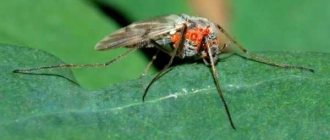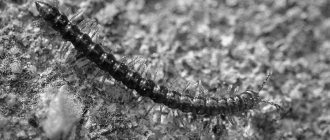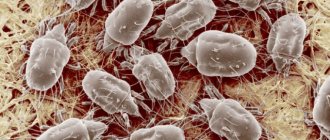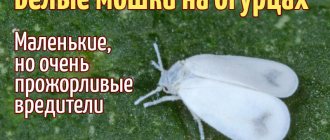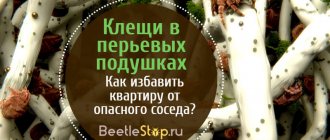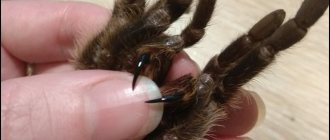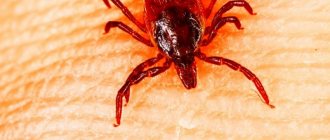Spider mite
Spider mites are common everywhere except Antarctica. It affects crops both in open and protected ground.
This is a small arthropod sucking insect measuring no more than 1 mm. The pest has a soft, ellipsoidal body with a convex upper part and a flat lower part.
At different stages of development, the tick has its own coloration . Transparent larvae are light green or brown with dark spots on the sides. The body of an adult insect has an orange-red, bright red, yellow, and green tint. They, unlike six-legged larvae, always have 8 legs.
Description of the pest
Spider mites are microscopic insects from the order of arachnids. The pest of garden and indoor crops is widespread. There are more than a thousand varieties of this parasite. The body length of a spider mite is only 0.2 - 0.6 mm : it is almost impossible to see it without a microscope. The largest spider mite specimen in the adult stage was 5 mm.
Under a magnifying glass, the insect has two pairs of eyes and four pairs of legs. The older and more well-fed the tick, the larger its size. The upper part of the body is round, ellipsoidal in shape. The bottom is flat.
The color range of individuals varies: larvae and young ticks can be from transparent to green-brown. On the sides there are transparent fabrics through which the internal digestive organs are visible. Older individuals gradually change color to orange. Adult ticks range in color from coral to bright red. Some species have a bright green or light green color, which is why they are often confused with aphids.
Hawthorn
It lives in warm regions of Russia, Ukraine, Tajikistan, Armenia, Moldova, Uzbekistan, Georgia, Kazakhstan, Azerbaijan, Western Europe, China, Korea, Japan.
It feeds on fruit crops, both pome and stone fruit. Most often found on plums, sloe, peaches, apple trees, cherries, pears, and cherries.
It is distinguished by pronounced sexual dimorphism. Females are larger, reaching 0.55 mm in length, and males no more than 0.4 mm. The body color of females is dark red, males are green.
The initially colorless eggs gradually acquire a pinkish-green color. Larvae and nymphs are painted with black spots on a light green background.
It is considered one of the most harmful types of spider mites. When there is severe aridity, it begins to multiply en masse, entangling branches, leaves and trunks with its web. Often leads to the death of fruit trees.
Read our article on how to fight spider mites on raspberries, currants, strawberries and grapes.
Reasons for appearance
A spider mite attack is an unpredictable thing. The pest can appear in the most unexpected places: for example, on barely planted seedlings of tomatoes or cucumbers, or on your favorite lemon tree, which has been growing in the apartment for many years.
Microscopic pests and eggs spread through:
- Free-ranging animals;
- When there are gusts of wind;
- Human;
- Contaminated soil;
- Infected planting material (seeds, shoots, cuttings).
The pest overwinters in fallen leaves and soil.
Over the course of a year, from 10 to 20 generations can grow in an apartment, from 10 to 15 in a heated greenhouse, and 3-4 generations in a greenhouse without heating or on the street. Spider mites pierce leaves and stems, feed on plant sap and are absolutely unpretentious in food. It settles on indoor plants, weeds, vegetables, tops of root crops, shrubs and trees. The pest, which itself is a carrier of diseases, can introduce viral and fungal infections, mainly gray rot, into the puncture sites.
Destruction methods
There are many ways to combat the red flat mite and here are some of them.
Non-chemical methods
An abundance of host plants, a warm, humid climate and few natural enemies provide favorable conditions for high population densities of this mite. Therefore, creating conditions contrary to this does not support active reproduction of the pest. The best option for combating red mites, which is accepted in greenhouse conditions, is to lower the temperature as much as possible so that it does not harm the plants and is not economically expensive.
Biological control
At least four predators of the red flat mite are known. These include three larger ticks and one beetle:
- Phytoseiulus macropilis.
- Amblyseius largoensis (Muma).
- Mexecheles hawaiiensis (Baker).
- Sticholotis beetle.
Predatory mites, P. macropilis and A. largoensis feed on red mite eggs but do not attack other life stages of the pest. Larvae, nymphs and adults of M. hawaiiensis attack all active stages of the red flat mite. As for the sticholothis beetle, it is used to control the scale of the red mite in China and Japan, where the pest is also very numerous. The bug loves to feast on all stages of the pest, and it does absolutely no harm to plants.
The predators mentioned above generally do not provide economic control, since their predation only becomes apparent when the prey population density is very high. Therefore, this type of struggle is relevant only on an industrial scale.
Sticholotis beetle - enemy of red mites
Chemical control
Because this mite reproduces parthenogenetically, like most other false spider mites, they do not have the genetic variation that occurs when mixing with most species of mites that reproduce sexually. Thus, pesticide resistance is less likely and less of a problem. Despite this, the red flat mite is resistant to certain organophosphates and is susceptible to most acaricides. In addition, resistance may develop if pesticide use has been very frequent.
Chemical sprays should be applied to affected plants at 2-3 week intervals if the infestation is severe. Any of the registered acaricides is usually effective. But sulfur should not be used in places where the relative humidity is abnormally low.
Symptoms of appearance
Recognizing the pest and distinguishing it from others is quite simple: upon careful examination of the plant, dried leaves can be seen. On their surface there are numerous spots of white or yellow color, resembling pinpoint burns in appearance. The lower part of the leaf blade is covered with an almost invisible web. The larger the web, the larger the colony of mites . As soon as the web reaches the top of the plant, the dried leaves fall off and the specimen dies.
Expert opinion
Vera Ivanovna Sh
Since childhood, I have been interested in growing indoor flowers, then I decided to devote my life to landscape design and gardening.
Most often, spider mites are not noticed until the seedling dies. Therefore, a weekly preventive examination is necessary, which will allow timely identification of the invisible enemy.
Main features:
- Web on the bottom of the leaf blade;
- Foliage drying out for no reason;
- White bald spots, yellow dots and spots on the leaf blade or along its edges;
- Some types of pests with a bright red-orange color are clearly visible.
Wide
A resident of South America, in Europe it is most often found in homes and indoor spaces . In food it prefers citrus fruits, euonymus, cacti, oleander, ficus, Saintpaulia, aucuba, tagetis.
They are easily removed pests, since the eggs are always on the leaves and do not hide in hard-to-reach places.
The dimensions are microscopic - no more than 0.3 mm.
The body is oval, brown with a red tint.
Lives on the lower surface of leaves .
Varieties
In our country, the most common varieties are:
Common spider mite
Common spider mite (Tetranychus urticae). An insect of light or green color settles on garden crops , including tomatoes, cucumbers, basil, lettuce, currants, raspberries, gooseberries, strawberries, and sweet peppers. Does not disdain indoor roses, tradescantia, geranium, asparagus and any other available flowers.
Red spider mite
Red spider mite (Tetranychus cinnabarinus). The small insect most often ends up in apartments with exotic plants or soil. Found on orchids, indoor and outdoor roses, citrus trees, and palm trees.
In the photo there is a common and red spider mite
Atlantic spider mite
Atlantic spider mite (Tetranychus atlanticus). Unlike its counterparts, the pest prefers conditions of high humidity. As a rule, such a tick feeds on palm trees, citrus and fruit trees, melons, and ornamental conifers. It can be found on cypresses, thujas, and junipers.
Cyclamen spider mite
Cyclamen spider mite (Phytonemus pallidus). The pest prefers to settle in soils. It feeds on bulbous garden plants and flowers - lilies, tulips, petunias, daisies, azaleas, dahlias and others. At home, it often affects violets, cyclamens, chrysanthemums, geraniums, fuchsias, and begonias. The smallest pest. The colony looks like a coating of gray dust.
In the photo there is an Atlantic spider mite and a cyclamen
Why are red ticks dangerous?
They spread wherever they find food - plants. They settle on any species - fruit trees and shrubs, nuts, citrus fruits, conifers, decorative flowering and deciduous indoor and greenhouse or hothouse plants. They suck out juice enriched with nutrients so necessary for plant development. But due to its small size, the presence of the pest is often discovered when the colony has grown greatly.
Signs of plant infection
You can determine that ticks have settled in by the following signs:
- dotted colorless spots on damaged leaves;
- large lesions (look like grayish-red spots on the surface of leaves or a coating of dust);
Dust spots on the leaves are a sign that red mites have settled on the plant. - yellowing of plant parts;
- drying and falling off of leaves or flowers;
- stopping the development of the plant, which cannot be explained by other reasons;
- the presence of cobwebs.
Ways to fight
There are many ways to combat spider mites. A tenacious insect is quite difficult to destroy. Most often, when traditional methods fail to defeat the enemy, they resort to aggressive chemistry. Let's talk about the most effective folk remedies and biological preparations.
Folk
- Garlic tincture. For 1 liter of boiled warm water, squeeze or finely chop 2-3 large heads of garlic. Leave for 5-7 days in a dark place, then dilute the tincture in a 1 to 1 ratio with water and spray the prepared plant.
- Tincture on laundry soap. Dilute the mixture at the rate of 1 piece of soap per 12 liters of water, spray the seedling and soil. Seal with a plastic bag for a day.
- Strain a decoction of 0.5 kg of roots and 0.5 kg of dandelion leaves into 10 liters of water. Spray the plant and soil. Repeat after 10 days.
- Tincture of shag or tobacco. Pour 0.5 kg of shag and 10 g of laundry soap into 10 liters of water and leave for 24 hours. Strain the solution and spray the plant.
- Alcohol and alcohol solutions can only be used on plants with dense, large leaves.
Before using any product, it is necessary to thoroughly wash the plant with water, remove damaged leaves and stems, and in the apartment, wash the windows and window sills. Treated plants should be quarantined. Most often, re-processing is required.
Store-bought drugs
Most chemicals used to control spider mites are toxic. When processing garden and indoor plants, follow safety precautions. Protect exposed parts of the body with overalls and gloves, and eyes with goggles. Don't forget to wear a respirator.
Non-toxic long-acting drugs: Iskra-Bio, Kleschevit, Tiovit-Jet, Bitoxibacillin, Fitoverm, Fufanon-Nova. Suitable for treating indoor and outdoor crops, including fruit-bearing crops, immediately before harvest.
Toxic preparations for treating street and greenhouse plants: Apollo, Actofit, Aktellik, Agravertin, Bicol, Vertimek, Demitan, Envidor, Karate, Neoron, Nissoran, Omite, Sunmite, Skelta, Flumite, and others.
Depending on the chosen drug, treatment is carried out several times with an interval of one week to several months. When choosing a drug, you should take into account the manufacturer’s recommendations: the order of dilution of the composition, the method of processing, the crops to be treated, and other nuances.
Prevention
To prevent the disease in epidemiological regions, vaccinations against encephalitis are given to the local population, guests, and specialists staying there for work. To avoid a tick bite, follow certain rules:
- in the forest they wear clothes made of thick fabric with cuffs and drawstrings;
- be sure to wear socks and a hat;
- you need to examine the body every 2 hours, carefully after returning home;
- things are immediately thrown into the wash;
- To repel pests, repellents are used - Taiga, Off, Raptor, Raid, etc., essential oils;
- If you frequently stay in the forest, it is recommended to wear special suits with traps impregnated with insecticidal substances.
Chemicals are used to bait ticks in the forest, garden, country house, and garden plot.
Use in folk medicine
The hemolymph of the red mite has a fairly powerful fungicidal effect. In this regard, it is widely used in folk medicine of the people of India. It is used to prevent paralysis, and also as an aphrodisiac: it is believed that the oil obtained from red beetles increases sexual desire. In modern medicine, this issue is still at the stage of consideration. Scientists are just looking at these arthropods as a potential source of immunomodulators.
Source
Most likely routes of spread
The pest has one peculiarity - it is practically impossible to infect plants from the street with it, since it cannot stay outside its place of residence for a long time. Healthy plants become infected only from sick relatives through their introduction. Since the bite is completely invisible, this becomes the main reason for the proliferation of red mites. That is why each new plant should be carefully examined using magnifying devices.
Mites suck out quite a lot of leaf cells, which leads to a decrease in the process of photosynthesis. The plant weakens greatly and becomes easy prey for many diseases and other pests. This means that the death of plants does not occur as a result of direct small bites, but rather from their consequences, since they provoke an outbreak of other diseases that are more dangerous for the flora.
Where do houses come from?
Often, spider mites come into your home along with new plants purchased at the market. Therefore, we strongly recommend that you purchase green friends only in trusted stores with good storage conditions and comfortable temperatures, where you can carefully inspect the seedlings.
Spider mites grow in the ground without any problems . During the wintering period, females hide in the soil, and the larvae can remain in it for up to five years without dying. In apartments, ticks are active in winter, when the air is dry. This provokes the heating to be turned on, while the windows and balconies are tightly closed.
Important ! If you notice that your favorite plant is infected with a parasite, it is better to isolate it in a separate place, since the mite can quickly migrate to other plants.
Another way you can bring a tick into your home is with a bouquet of flowers.
Let's look at how to visually identify an infected plant :
- the leaf looks as if it has been pierced with needles;
- the presence of dried leaves and buds;
- slowing down plant growth;
- black dots on the back of the leaf are the mites themselves;
- the presence of cobwebs on the leaf;
- large population on the web.
Why does a spider crawl in bed, on a bed, on a pillow: a sign
- On the hand - a generally positive sign.
- On the left hand - to wasteful spending.
- On the right hand - extra money will appear.
- Crawling along your arm or shoulder - soon you will meet an old acquaintance or receive a message from him.
- Sat on your hand - also a positive meaning.
- Crawling up your hand - your loved ones or friends want something from you.
- On your face - something good awaits you in the near future.
- Came down from the ceiling in front of your face - a positive sign. Your business portends success for you, you will be prosperous.
- Slowly spinning a web in front of your face is also positive.
- On your feet - to new acquisitions.
- Crawling up the leg - to large purchases.
- Crawling over a person’s body - to monetary rewards.
- Why is he running all over me? Perhaps they will give you a bonus.
- Sits on the body - soon there will be financial well-being if you don’t give up.
- On the neck - perhaps your loved ones will help or please you with something.
- On your hair - expect guests. Hair is associated with cobwebs, so the sign is favorable.
- Crawling up clothes - you will buy yourself new clothes or personal items.
- On shoes - you will have to lose something or spend a lot of money.
- In a circle - you have an envious person.
- A spider crawls up your body - the business you are doing will bring you success, harmony and prosperity.
- A spider is crawling down your body - most likely, you will soon experience minor financial difficulties.
- A spider crawls along your right hand - a good job with sufficient income will come your way.
- A spider crawls along your left hand - do not lend money, it may not come back to you.
- A spider crawls along your right leg - a person you will meet soon can give you wealth and prosperity.
- A spider crawls along your left leg - due to quarrels and damaged relationships with loved ones, you risk losing your income.
- A spider crawls across your chest - your health is not in the best condition.
- A spider crawling on your head - a sign foretells pleasant changes for you in the near future, perhaps a meeting with a good person or news.
- A spider crawls along your right shoulder - you risk doing the wrong thing.
- A spider crawls along your left shoulder - extra spending can ruin you.
Spider and signs associated with it
Signs and interpretation:
- The spider crawls across the floor to the left - do not borrow money from anyone in the near future, it may not come back to you.
- A spider crawls across the floor to the right - most likely, your debt will soon be returned or someone will be able to help you financially.
- A spider crawling across the floor towards you means pleasant changes in life, good news.
- A spider crawls across the floor away from you - protect yourself from waste and communication with unpleasant people.
- A spider crawling along the ceiling to the right is a good omen, you will be in abundance, your expenses will not ruin you. The profit will be much greater.
- A spider crawls along the ceiling to the left - a sign that your financial situation will be quite good, but you should still protect yourself from unnecessary waste.
- A spider descending from the ceiling is a bad omen, foreshadowing a financial “hole”: debts, loans, ruin.
- A spider on the wall is a good omen, which tells you that your financial situation will improve in the near future.
- A spider crawling down the wall portends spending, wasting money, problems with debts and losses in gambling.
- A spider crawling along the wall to the right means that you will be able to get good benefits from odd jobs.
- A spider crawls along the wall to the left - a little financial help from loved ones.
Correct interpretation of signs with spiders
- A spider descended on your head - a favorable meeting with a good person, prosperity and well-being.
- A spider descended on your hand - soon you will be lucky enough to find a source of additional income.
- A spider descended on your hair - you will receive good news or you will meet a significant person.
- A spider has descended on your face (nose, eye, mouth) - take care of yourself from diseases, “bad” people with the “evil eye”.
- A spider descended in front of your face is a good omen that portends many pleasant events in your life.
- A spider on the bed means betrayal by one of the spouses or possible deception on the part of a loved one.
- A spider on the wall near the bed means that one of the spouses has a rival.
- A spider crawled out from under the bed - deception and betrayal of one of the spouses, a loved one.
- Spider on the pillow - male infidelity
- A spider on the ceiling above the bed - quarrels, problems and scandals caused by the betrayal of spouses.
The spider and the signs it brings
Let's sum it up
In some cases, the mite can cause mass mortality of poultry, so farmers, regardless of the method of keeping chickens, should not exclude this possibility. It is better to carry out preventive treatment first and protect individuals from parasites.
Video - Process of treating chickens for parasites
Nikolay Zhuravlev chief editor
Author of publication November 22, 2018
Did you like the article? Save so you don't lose!
Chicken mites cause a lot of problems not only for the birds themselves, but also for farmers and poultry farmers. In the event of infection with a dangerous ectoparasite, laying hens' productivity decreases and the condition of their feathers deteriorates. Chickens and young broiler breeds infested with feather mites lag behind in growth and development compared to their healthy peers and slowly gain weight. Despite the fact that parasitic mites are most active in the warm season, birds can become infected in any season. How dangerous are chicken mites? How to fight and completely get rid of chicken mites?
